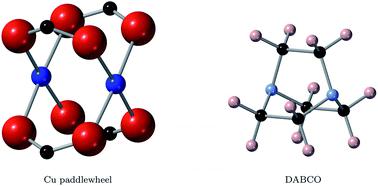当前位置:
X-MOL 学术
›
J. Mater. Chem. A
›
论文详情
Our official English website, www.x-mol.net, welcomes your
feedback! (Note: you will need to create a separate account there.)
Ligand engineering in Cu(II) paddle wheel metal–organic frameworks for enhanced semiconductivity
Journal of Materials Chemistry A ( IF 10.7 ) Pub Date : 2020-06-17 , DOI: 10.1039/d0ta04466k Matthias J. Golomb 1, 2, 3, 4 , Joaquín Calbo 5, 6, 7, 8 , Jessica K. Bristow 9, 10, 11, 12 , Aron Walsh 1, 2, 3, 4, 13
Journal of Materials Chemistry A ( IF 10.7 ) Pub Date : 2020-06-17 , DOI: 10.1039/d0ta04466k Matthias J. Golomb 1, 2, 3, 4 , Joaquín Calbo 5, 6, 7, 8 , Jessica K. Bristow 9, 10, 11, 12 , Aron Walsh 1, 2, 3, 4, 13
Affiliation

|
We report the electronic structure of two metal–organic frameworks (MOFs) with copper paddle wheel nodes connected by a N2(C2H4)3 (DABCO) ligand with accessible nitrogen lone pairs. The coordination is predicted, from first-principles density functional theory, to enable electronic pathways that could facilitate charge carrier mobility. Calculated frontier crystal orbitals indicate extended electronic communication in DMOF-1, but not in MOF-649. This feature is confirmed by band structure calculations and effective masses of the valence band edge. We explain the origin of the frontier orbitals of both MOFs based on the energy and symmetry alignment of the underlying building blocks. The effects of isovalent substitution on the band structure of MOF-649 are considered. Our findings highlight DMOF-1 as a potential semiconductor with enhanced 1D charge carrier mobility along the framework.
中文翻译:

铜(II)桨轮金属-有机骨架中的配体工程可增强半导电性
我们报告了两个金属有机框架(MOF)的电子结构,其铜桨轮节点通过N 2(C 2 H 4)3连接(DABCO)配体具有易于接近的氮孤对。根据第一性原理密度泛函理论,预测了该配位作用,以实现可促进电荷载流子迁移的电子路径。计算出的前沿晶体轨道表明在DMOF-1中扩展了电子通信,但在MOF-649中却没有。该特征通过能带结构计算和价带边缘的有效质量得到证实。我们基于基础构件的能量和对称排列来解释两个MOF前沿轨道的起源。考虑了等价取代对MOF-649的能带结构的影响。我们的发现强调了DMOF-1是一种潜在的半导体,具有沿框架增强的1D电荷载流子迁移率。
更新日期:2020-07-07
中文翻译:

铜(II)桨轮金属-有机骨架中的配体工程可增强半导电性
我们报告了两个金属有机框架(MOF)的电子结构,其铜桨轮节点通过N 2(C 2 H 4)3连接(DABCO)配体具有易于接近的氮孤对。根据第一性原理密度泛函理论,预测了该配位作用,以实现可促进电荷载流子迁移的电子路径。计算出的前沿晶体轨道表明在DMOF-1中扩展了电子通信,但在MOF-649中却没有。该特征通过能带结构计算和价带边缘的有效质量得到证实。我们基于基础构件的能量和对称排列来解释两个MOF前沿轨道的起源。考虑了等价取代对MOF-649的能带结构的影响。我们的发现强调了DMOF-1是一种潜在的半导体,具有沿框架增强的1D电荷载流子迁移率。











































 京公网安备 11010802027423号
京公网安备 11010802027423号